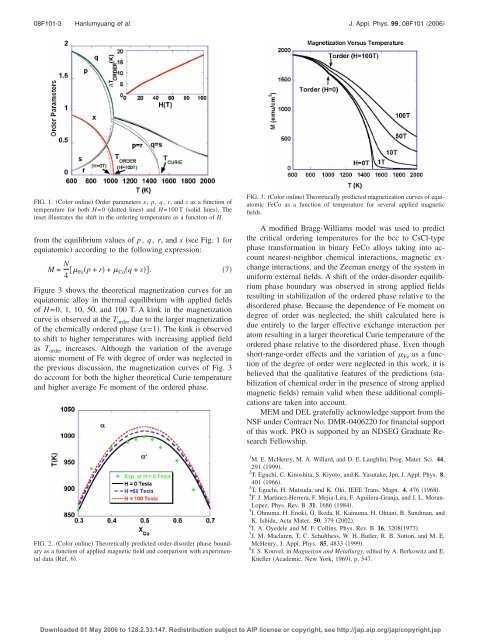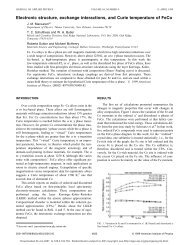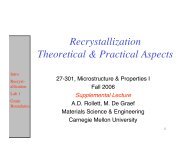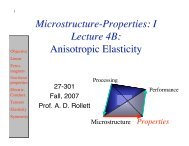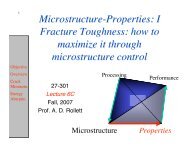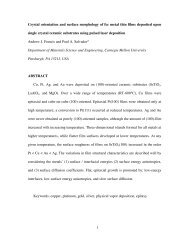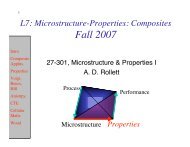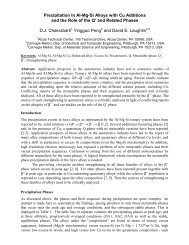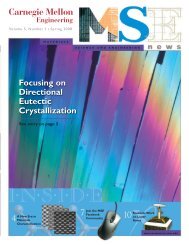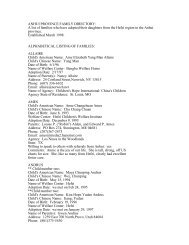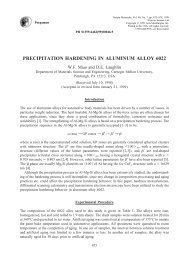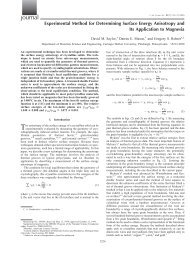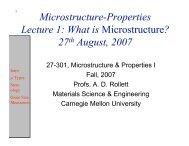Bragg-Williams model of Fe-Co order-disorder phase - ResearchGate
Bragg-Williams model of Fe-Co order-disorder phase - ResearchGate
Bragg-Williams model of Fe-Co order-disorder phase - ResearchGate
You also want an ePaper? Increase the reach of your titles
YUMPU automatically turns print PDFs into web optimized ePapers that Google loves.
08F101-3 Hanlumyuang et al. J. Appl. Phys. 99, 08F101 2006<br />
FIG. 1. <strong>Co</strong>lor online Order parameters x, p, q, r, ands as a function <strong>of</strong><br />
temperature for both H=0 dotted lines and H=100 T solid lines. The<br />
inset illustrates the shift in the <strong>order</strong>ing temperature as a function <strong>of</strong> H.<br />
from the equilibrium values <strong>of</strong> p, q, r, and s see Fig. 1 for<br />
equiatomic according to the following expression:<br />
M = N<br />
4 <strong>Fe</strong>p + r + <strong>Co</strong>q + s. 7<br />
Figure 3 shows the theoretical magnetization curves for an<br />
equiatomic alloy in thermal equilibrium with applied fields<br />
<strong>of</strong> H=0, 1, 10, 50, and 100 T. A kink in the magnetization<br />
curve is observed at the T<strong>order</strong> due to the larger magnetization<br />
<strong>of</strong> the chemically <strong>order</strong>ed <strong>phase</strong> x=1. The kink is observed<br />
to shift to higher temperatures with increasing applied field<br />
as T<strong>order</strong> increases. Although the variation <strong>of</strong> the average<br />
atomic moment <strong>of</strong> <strong>Fe</strong> with degree <strong>of</strong> <strong>order</strong> was neglected in<br />
the previous discussion, the magnetization curves <strong>of</strong> Fig. 3<br />
do account for both the higher theoretical Curie temperature<br />
and higher average <strong>Fe</strong> moment <strong>of</strong> the <strong>order</strong>ed <strong>phase</strong>.<br />
FIG. 2. <strong>Co</strong>lor online Theoretically predicted <strong>order</strong>-dis<strong>order</strong> <strong>phase</strong> boundary<br />
as a function <strong>of</strong> applied magnetic field and comparison with experimental<br />
data Ref. 6.<br />
FIG. 3. <strong>Co</strong>lor online Theoretically predicted magnetization curves <strong>of</strong> equiatomic<br />
<strong>Fe</strong><strong>Co</strong> as a function <strong>of</strong> temperature for several applied magnetic<br />
fields.<br />
A modified <strong>Bragg</strong>-<strong>Williams</strong> <strong>model</strong> was used to predict<br />
the critical <strong>order</strong>ing temperatures for the bcc to CsCl-type<br />
<strong>phase</strong> transformation in binary <strong>Fe</strong><strong>Co</strong> alloys taking into account<br />
nearest-neighbor chemical interactions, magnetic exchange<br />
interactions, and the Zeeman energy <strong>of</strong> the system in<br />
uniform external fields. A shift <strong>of</strong> the <strong>order</strong>-dis<strong>order</strong> equilibrium<br />
<strong>phase</strong> boundary was observed in strong applied fields<br />
resulting in stabilization <strong>of</strong> the <strong>order</strong>ed <strong>phase</strong> relative to the<br />
dis<strong>order</strong>ed <strong>phase</strong>. Because the dependence <strong>of</strong> <strong>Fe</strong> moment on<br />
degree <strong>of</strong> <strong>order</strong> was neglected, the shift calculated here is<br />
due entirely to the larger effective exchange interaction per<br />
atom resulting in a larger theoretical Curie temperature <strong>of</strong> the<br />
<strong>order</strong>ed <strong>phase</strong> relative to the dis<strong>order</strong>ed <strong>phase</strong>. Even though<br />
short-range-<strong>order</strong> effects and the variation <strong>of</strong> <strong>Fe</strong> as a function<br />
<strong>of</strong> the degree <strong>of</strong> <strong>order</strong> were neglected in this work, it is<br />
believed that the qualitative features <strong>of</strong> the predictions stabilization<br />
<strong>of</strong> chemical <strong>order</strong> in the presence <strong>of</strong> strong applied<br />
magnetic fields remain valid when these additional complications<br />
are taken into account.<br />
MEM and DEL gratefully acknowledge support from the<br />
NSF under <strong>Co</strong>ntract No. DMR-0406220 for financial support<br />
<strong>of</strong> this work. PRO is supported by an NDSEG Graduate Research<br />
<strong>Fe</strong>llowship.<br />
1<br />
M. E. McHenry, M. A. Willard, and D. E. Laughlin, Prog. Mater. Sci. 44,<br />
291 1999.<br />
2<br />
T. Eguchi, C. Kinoshita, S. Kiyoto, and K. Yasutake, Jpn. J. Appl. Phys. 8,<br />
401 1966.<br />
3<br />
T. Eguchi, H. Matsuda, and K. Oki, IEEE Trans. Magn. 4, 4761968.<br />
4<br />
F. J. Martinez-Herrera, F. Mejia-Lira, F. Aguilera-Granja, and J. L. Moran-<br />
Lopez, Phys. Rev. B 31, 1686 1984.<br />
5<br />
I. Ohnuma, H. Enoki, O. Ikeda, R. Kainuma, H. Ohtani, B. Sundman, and<br />
K. Ishida, Acta Mater. 50, 379 2002.<br />
6<br />
J. A. Oyedele and M. F. <strong>Co</strong>llins, Phys. Rev. B 16, 32081977.<br />
7<br />
J. M. Maclaren, T. C. Schulthess, W. H. Butler, R. B. Sutton, and M. E.<br />
McHenry, J. Appl. Phys. 85, 4833 1999.<br />
8<br />
J. S. Kouvel, in Magnetism and Metallurgy, edited by A. Berkowitz and E.<br />
Kneller Academic, New York, 1969, p. 547.<br />
Downloaded 01 May 2006 to 128.2.33.147. Redistribution subject to AIP license or copyright, see http://jap.aip.org/jap/copyright.jsp


